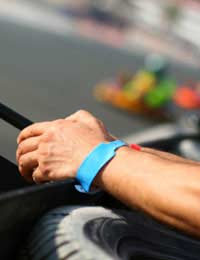Karting in Wet Weather

In wet weather, you need to adopt a different driving approach to help you adapt to the conditions. In particular, braking and cornering and picking the best racing line can become more challenging in wet conditions. Karting in the wet is much more physical compared to karting in the dry, and it pays to adopt a more aggressive approach than you otherwise would.
Racing Lines
It's tempting to pick the driest racing line but this isn't always the best option as your fellow karters are likely to have had exactly the same idea. This racing line will then probably accumulate tyre debris, making it difficult to find enough grip and it can potentially be very slippy when the rubber gets wet. Because of this, it's usually safer to take the racing line that you would normally go for in the dry and alter your braking and cornering techniques.A quick glance at a wet track will usually reveal two different racing lines. The darker of these indicates the racing line that has picked up rubber debris and this is the one to avoid. Instead, aim for the lighter racing line when karting in wet conditions. This will often be on the outside of corners.
Braking
A more aggressive approach to braking can work wonders in the wet. Hitting the brake pedal sharply will encourage the brakes to lock and 'bite' the track so that you can get maximum grip. The aim is not to press down on the brake for very long as you can find yourself skidding across the track, or even inadvertently leaving the track altogether. You should have finished braking before you turn into a corner.Cornering
On the approach to a corner, turn in as late as you can and turn the steering wheel sharply to encourage the tyres to lock while leaning forwards to the outside of the kart. Ideally, this should make the tyres 'bite' the track to improve grip levels so that you're less likely to experience sliding. This enables the weight to move from the rear of the kart to the front so that the inside rear wheel can be lifted while taking the corner.If you've done this correctly, the kart should 'snap' into a corner in a quick and lively movement. Once the kart has turned into the corner, sit back again to re-balance the weight distribution so that the weight is balanced back across the rear of the kart again, correct the steering wheel so that it is central again and gently accelerate so that the power builds up gradually after exiting the corner. This can be difficult to perfect and you may find that you need a considerable amount of practice before you get the technique right. This is normal, so don't feel bad if you can't get it right straight away! The front end will slide slightly and acts as a front brake so you shouldn't be travelling too quickly during this process.
General Driving Style
The need to be aggressive extends beyond braking and cornering, and a reserved driving style is likely to land you in trouble when karting in the wet. You need to be more physical with the kart than you normally would.- Top Foods for Slow Release Energy on Race Day
- An Introduction to Race Strategy
- Assessing the Track Pre-race
- Race Day Food and Drink
- A Guide to Overtaking
- Achieving a Successful Race Start
- Qualifying Tips for Karting Competitions
- Kart Racing: Recovering Motivation After Losing
- Tips and Advice For Go Kart Race Training
- 2 Stroke Racing
- 4 Stroke Racing
- Staying Focused During Racing
- Go Kart Racing Categories
- Racing Formats


Re: Top Foods for Slow Release Energy on Race Day
Hi I want to strat race a 250 rotax kart at any hints. Do I need a race licence
Re: Gaining Sponsorship
Hey, I'm a small rental gokarter based in Scotland, Glasgow. I race at cambuslang and I'm top 10 at the track I have a lot of friends at…
Re: Outdoor Karting vs Indoor
I've enjoyed go karting since I was a little child
Re: Go-Karting Insurance
This would be for my sons gokart
Re: 2 Stroke Racing
Hi there I have got a come cadet Rotax engine what fuel do I need
Re: 2 Stroke Racing
I have 2 stroke kersone engine with 196cc 7hp engine how fast would it go?
Re: Gaining Sponsorship
I'm Craig Shiluvane from South Africa looking for a sponsor to continue with my career of racing There is a lot opportunities in the UK and…
Re: Nutrition For Go-karters
Boom this really worked as I used to weigh 6”6 stone but now I way a whopping 4”5
Re: Building A Go-Kart
Hi , ive got a chassis and i want to build it from scratch but dont know how to get correct parts for it THIS IS ALL I KNOW ? F100…
Re: Go Kart Transmission System
Is Gokart transmission system having clutches and gears ? Than how gears system is used without mounting differential gear box ?